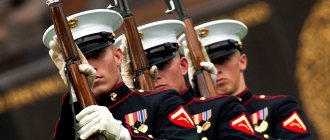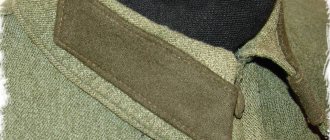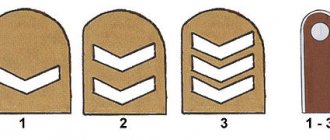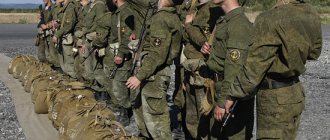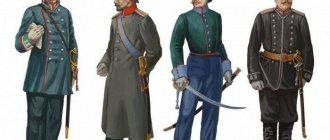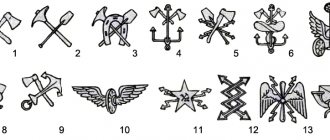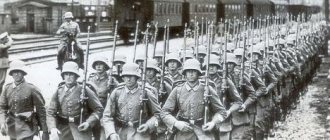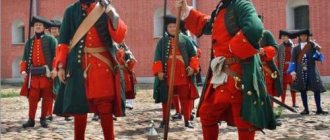On March 23, 2022, Order No. 89 of the Minister of Defense came into force, “On amending Appendix No. 1 to Order No. 300 of the Minister of Defense of the Russian Federation dated June 22, 2015, “On approval of the Rules for wearing military uniforms, insignia, and departmental insignia.” distinctions and other heraldic signs in the Armed Forces of the Russian Federation and the Procedure for mixing items of existing and new military uniforms in the Armed Forces of the Russian Federation.”
In accordance with it, all military personnel undergoing military service under a contract in the positions of soldiers (sailors), sergeants and foremen are required to wear sleeve patches indicating the number of years that the serviceman has served in the army.
In everyday life, sleeve patches based on length of service are often called one-year patches .
The appearance of insignia in the army
Military ranks in Russian regiments appeared in the 14th and 15th centuries. Then the uniform distinguished the commander of the Streltsy troops from the private with the help of a camisole embroidered with galloon and a caftan. Officers' hats were also embroidered with gold. There were no other insignia.
Shoulder straps were introduced into the army only in 1801. They were marked with part numbers. And the type of army could be determined by special monograms. Epaulets became a distinctive sign of senior officers.
After the revolution, Red Army soldiers wore a badge on their chests with wreaths of oak and laurel branches intertwined around the edges. In the middle there was an image of a red star, against the background of which the symbol of the union of worker and peasant - a plow and a hammer - was depicted.
It was not for nothing that the army was called the workers' and peasants' army, since it consisted of people from the working class and the peasantry. In 1935, insignia appeared in accordance with the rank of the serviceman and the branch of the military. The shoulder straps of the Tsarist army were considered a relic of the past, and they were abandoned. But in 1943 they were returned.
History and essence of shoulder straps in the army
Elements of military uniforms have their own special purpose and appeared under the influence of historical events. For the first time, shoulder straps began to be used to hold the strap of a grenadier's bag or backpack. There was only one shoulder strap and was sewn on the left shoulder.
The lower edge was sewn tightly, and the upper edge was fastened to a button located on the caftan. The prerogative to wear shoulder straps was only for foot soldiers in the era of Peter the Great. There was an element missing from the cavalry and artillerymen.
Membership in a particular regiment began to be determined by shoulder straps in the mid-18th century. The weaving of cord on shoulder straps was different for soldiers and officers. But due to the fact that the regiment commanders themselves determined the type of weaving, confusion began in the insignia.
Shoulder straps were finally returned only during the reign of Alexander I. The regulations concerned the colors of the emblem. The regiment number was stamped on it. The officers' shoulder straps were trimmed with gold braid. Now the shoulder strap was needed not only to hold the strap from the bag or satchel, but also as a badge of rank for soldiers and officers. Since 1803, shoulder straps have appeared on both shoulders.
The Nicholas era is marked by the appearance of epaulettes to distinguish the ranks of officers and generals of the army. Since the middle of the 19th century, the role of shoulder straps has been defined to distinguish military ranks, such as non-commissioned officer and soldier. A little later, officers switched from epaulettes to shoulder straps, which were more convenient to wear.
When the form element was no longer needed to hold the strap from the bag, they began to sew it tightly into the overcoat. The shoulder strap lasted until 1917-1918, appearing on the shoulders of soldiers and officers of the Soviet army during the Great Patriotic War.
Insignia of the Red Army
The abandonment of shoulder straps led to the appearance of other insignia of military ranks, unique in their kind. It was possible to distinguish an officer from a soldier in the Red Army by the shape of their emblems. Representatives of the high command sewed diamonds into their buttonholes, which were later replaced with five-pointed stars.
Senior officers were required to wear rectangles, or sleepers, and junior officers - cubes or squares, called kubars. Triangular patches in the buttonholes of the uniform were intended for sergeants.
The diamond was used to determine who was a member of the high command by rank:
- The marshal has a large gold star on a red background framed by laurel branches.
- General positions began with 5 small stars. Their number decreased from the rank of general to major general (2 stars).
- The brigade commanders had a clean diamond in their buttonhole.
The colonel was identified by 4 sleepers on his buttonhole. The reduction came from lieutenant colonel (3 sleepers), major (2 sleepers), captain (1 sleeper). All ranks had a narrow strip sewn onto the buttonhole along the edge and a golden triangle in the upper corner. The Red Army soldiers were distinguished by an empty buttonhole without stripes.
Sleeve patches in the army were assigned the role of distinguishing by ranks and ranks. Chevrons were used only by combat ranks. For some ranks they were the same. For political instructors, a sleeve patch was used in the form of a red star with the symbol of the Soviet state embroidered on it in gold - a crossed hammer and sickle.
About the system of signs among military personnel of the Russian Federation
Assignment of class qualifications to military personnel
The main insignia in the modern Russian army include, as before, shoulder straps. But there are also emblems and other signs that are associated with:
- belonging to the branch of the military;
- rank;
- functional purpose;
- personal responsibility of the military personnel.
All insignia are correctly placed on uniforms and are also used at specific times.
Emblems of the military branches
The shape of the sleeve emblem of military personnel is round. In its center is the coat of arms of the Russian Federation. The background color depends on the type of troops:
- black – Navy;
- blue – airborne forces;
- blue – Air Force;
- red – ground forces.
The emblems on the sleeves are worn by military personnel of the engineering, border, and internal troops, and cadets of the Suvorov and Nakhimov schools. In addition, the emblems on shoulder straps and breast badges made of metal indicate that they belong to the military branches. Divisions have a certain type of stripe, which is worn by all personnel of the formations.
How to spot differences in ranks
On the shoulder straps of everyday clothing for military personnel who are not officers, two narrow longitudinal stripes are visible. At the bottom there is a shoulder strap of the letter ВС made of metal. The same insignia is worn by privates, sergeants and warrant officers.
Unlike soldiers and sailors, whose shoulder straps are clean, sergeants and foremen can be recognized by their fabric braid, and warrant officers and midshipmen by small stars located vertically. Military school cadets have the letter K on their shoulder straps.
Starting with warrant officers, officer ranks go higher. By shoulder straps determine:
- junior officer - stripes and stars measuring 13 millimeters;
- senior officer - 2 stripes and stars of 20 millimeters;
- senior officer - only large stars vertically without stripes;
- general - on a star of 40 millimeters;
- Marshal - a star with silvery rays extending from it, forming a pentagon.
The shoulder straps are not much different from those that were in the USSR. The shape of the elements changed, they became the same for everyone, with 6 edges. The edgings on the shoulder straps have only 2 colors. Red - for ground forces and blue - paratroopers, air and missile forces.
Let's learn about the types of shoulder straps, their colors
Depending on the military rank, there are differences in the shoulder straps of military personnel. Soldiers, warrant officers, petty officers and sergeants are distinguished by red shoulder straps. Badges are sewn on winter coats and ceremonial jackets. Those serving in the aviation and landing forces are recognized by their blue colors, in the rest of the troops, except the Navy, they are black. There is no need to sew shoulder straps onto the field uniform, as they are removable.
At the parade, warrant officers are recognized by their khaki-colored shoulder straps with red, blue, or black trim. During exercises, camouflage shoulder straps should not be sewn on; they are simply removed.
The officers' ceremonial jacket has golden sewn shoulder straps with red, blue or black piping. On everyday clothes: jacket, coat - insignia is also sewn on, the rest of the uniform is removable. On the shirts there are signs of khaki color, and on the front - white.
Navy personnel have shoulder straps:
- sailors, foremen, midshipmen in full dress uniform - gray and black with squares arranged in a checkerboard pattern or everyday blue with a yellow letter F;
- officers on their ceremonial tunic have gold stitching with black piping along the sides;
- on a casual shirt - beige, on a dress shirt - golden, where there is no edging.
Wearing insignia requires caution. If the shoulder straps are damaged or missing, the serviceman will face punishment.
Rank insignia on shoulder straps
According to military ranks, the following are placed on shoulder straps:
- one star with or without blue edging, above it another star for army generals;
- three stars along the center line - colonel general;
- two stars - lieutenant general;
- one star for a major general;
- two stars in the middle of the longitudinal line and above another star - a colonel;
- two stars on both sides - lieutenant colonel;
- one star on the longitudinal center line - major;
- four stars, two at the bottom and at the top - captain;
- three stars - senior lieutenant;
- two - lieutenant;
- one - junior lieutenant.
The location of the stars, their sizes, the distance between them is determined by the Rules for wearing military uniforms and insignia by military personnel, which were approved in 2011, and supplemented and amended in 2016.
What do sleeve patches look like indicating service life?
Sleeve patches have the shape of golden squares or plain green for VKPO and have different thicknesses depending on the service life. The thickness of the angles can be of two types: 10 mm. meaning one year of service and 20 mm - meaning five years of service. The width of the angles located vertically above each other is 55 m, around them there should be a black edging equal to 3 mm. Accordingly, the width of the chevron is 61 mm. The height depends on the length of service of the soldier. The final type of sleeve patch is determined by adding the required number of squares depending on the number of years of service.
Dimensions of the chevron indicating service life
Appearance of the sleeve insignia depending on service life
Patch for 23 years of service (example)
Patch for 7 years of service, for VKPO (example)
This is what a year's worth of office uniform looks like, equal to 7 years of service in the Armed Forces.
How to place it on the form correctly
The military uniforms of the modern army have undergone changes, and therefore the stripes and shoulder straps are placed on them differently, not as before:
- The pocket flap on the left has a patch in the form of a strip of fabric with the initials and surname of the serviceman.
- On the right is the inscription Armed Forces of Russia.
- An emblem indicating the branch of the military is sewn on the left side of the sleeve.
- A metal cockade is placed on the headdresses of military personnel. The field uniform is combined with olive green emblems. In parades they wear headdresses decorated with silver or golden cockades.
- Navy personnel are distinguished by a black cockade with an anchor in the center.
Insignia fade over time, so they are replaced with new ones.
Order of wearing awards
In addition to insignia, the uniform may contain state awards of the Russian Federation and the USSR, as well as executive authorities of the constituent entities of the Russian Federation. The wearing of awards is provided for by the Presidential Decree of September 2010. The document prescribes a certain wearing order.
Badge ribbons can be worn on ceremonial clothing when not in formation. The badge of the Order of St. Apostle Andrew the First-Called, St. George, 1st class, For services to the Fatherland, 1st class, is worn on a ribbon thrown over the right shoulder.
The Order of St. Andrew the First-Called is worn on a chain. And if a serviceman is awarded the badge of the Order of St. George, 1st degree, then the latter is placed on the shoulder ribbon. The insignia of the Order of St. George and the Order of Merit to the Fatherland, II and III degrees, is attached to the neck ribbon. If there are both awards, they should be on the neck ribbon from top to bottom in order of seniority.
On the left side of the jacket they attach above the orders:
- Gold Star of the Hero of Russia;
- Gold Star of the Hero of the Soviet Union;
- Gold medal Hammer and Sickle from the Heroes of Socialist Labor.
Below the insignia there should be insignia of orders of lower rank. These include awards created in honor of great commanders and admirals of the fleet. Below the orders and medals on the left you can attach one below the other the Star of the Order.
On the right side of the form, they are placed in order, starting with the badge for the honorary title of the Russian Federation, then the insignia for impeccable service. Insignia of orders of the USSR may also be located there.
If orders and medals do not fit on the chest in one row, then they are attached to the second row from the center of the chest to the edge in order. The centers of the awards are placed on the same line, and the distance between the signs should be 1 centimeter. Insignia of the subjects of the Federation or departments of executive power are given a place below the state awards of Russia.
On a double-breasted woolen tunic or single-breasted vest, the marks are placed 7 centimeters below the lapel. On a summer jacket - symmetrically to the vertical axis of the chest pocket so that the lower side corners of the sign block are level with the upper edge of the pocket.
On the right side, the order of placement of badges is as follows:
- an award from the Main Directorate of Special Programs of the President of the Russian Federation, referred to as an Honorary Employee of the GUSP;
- then the turn for the Honorary Special Objects Service Officer;
- next – For service at special facilities, 1st degree.
Badges issued upon graduation from a military educational institution or cadet, Suvorov, Nakhimov school may be on the right. Military insignia on the right side of the uniform is attached from the center to the edge of the chest. There should be no more than 3 of them.
Ribbons of state awards located on the straps decorate the chest on the left side in the same order as the badges. They begin with the Order of the Holy Apostle Andrew the First-Called. They end with ribbons of medals from Russia and the Soviet Union. The height of the bars of the highest state awards is 12 millimeters, other orders and medals - 8.
Wearing insignia of state awards on field uniforms is prohibited. Only special insignia such as the Golden Star of the Hero of Russia or the Soviet Union can be placed on everyday uniforms. Instead of insignia of orders and medals, wearing strips of ribbons is allowed.
Requirements
Military personnel are required to take care of their shoulder straps and stripes and change them as they change military rank or move to other military units. Shoulder straps and emblems should be sewn or attached in accordance with the Rules for Wearing Military Uniforms. They should not be wrinkled, dirty, or with other inserts.
The following requirements apply to metal signs: images should not be dull or stained with dirt. The emblems need to be cleaned periodically. Do not use broken signs with cracks or chips on the form.
Military insignia are required in the army of any state. The history of their appearance in the Russian army is connected with the development of the state and political changes in the country. Each insignia has its own role and wearing rules.
Where should sleeve patches be placed?
Quote from the order Ministry of Defense :
In accordance with the order of the Minister of Defense of the Russian Federation dated 06/22/2015 N 300 (as amended on 02/07/2017) “On approval of the Rules for wearing military uniforms, insignia, departmental insignia and other heraldic insignia in the Armed Forces of the Russian Federation and the Procedure for mixing existing items and new military uniforms in the Armed Forces of the Russian Federation"
Sleeve insignia for the years of service of military personnel undergoing military service under contract in the positions of soldiers (sailors), sergeants and foremen, in the form of golden squares, are worn on the lower part of the outer sides of the sleeves of winter casual jackets, demi-season casual jackets, jackets with long sleeves of casual suits , naval suit jackets. On the jacket of the suit in summer camouflage colors, the sleeve insignia for years of service are in khaki color. Sleeve insignia according to the years of service of military personnel undergoing military service under a contract in the positions of soldiers (sailors), sergeants and foremen are placed at a distance of 100 mm from the bottom of the sleeves.
Sleeve insignia according to the years of service of military personnel undergoing military service under contract in the positions of soldiers (sailors), sergeants and foremen are worn on the lower part of the outer sides of the sleeves of winter casual jackets, demi-season casual jackets, long-sleeved jackets of casual suits, naval suit jackets, placed at a distance of 100 mm from the bottom of the sleeves
Placement of the sleeve patch on the VKPO
On the jacket of a suit of summer camouflage colors ( VKPO ), sleeve insignia for years of service must be khaki and placed at a distance of 100 mm from the bottom of the sleeves. These chevrons to the form using Velcro or can be sewn on.
Correct placement of one year old signs on office uniforms
